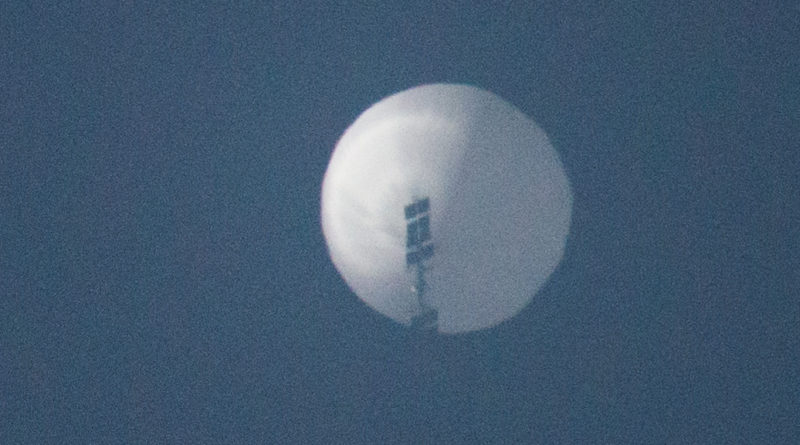Chinese balloon incident comes to an explosive end
Photo of Chinese surveillance balloon over Billings, Montana courtesy of Wikimedia Commons.
Lucy Waskiewicz | Contributing Writer
In a dramatic final act to days of international friction, the U.S. military has shot down a suspected Chinese spy balloon over the Atlantic Ocean.
The decision arrived after three days of remarkably publicized coverage on what is currently dubbed the 2023 China balloon incident. Reporting began on Feb. 2, when both the U.S. and Canada announced that they were cooperatively tracking a surveillance balloon that had entered both countries’ airspaces at an altitude of roughly 60,000 feet.
The balloon, which was described to be the size of about two or three school buses, was believed to belong to China.
According to U.S. officials, the balloon entered U.S. airspace above Alaska on Jan. 28, then drifted into Canadian airspace on Jan. 30. It returned to the U.S. on Jan. 31 when it crossed over northern Idaho and was subsequently spotted above Montana, Missouri and Carolinas before being downed off the South Carolina coast on Feb. 4.
The balloon was confirmed to belong to China on Feb. 3, when a spokesperson for China’s Ministry of Foreign Affairs stated that it was a meteorological research tool blown awry.
“It is a civilian airship used for research, mainly meteorological purposes,” the spokesperson said. “Affected by the Westerlies and with limited self-steering capability, the airship deviated far from its planned course.”
The spokesperson added that China regretted the incident.
The Pentagon held a media briefing on Feb. 3 to address the balloon, where press secretary Brigadier General Pat Ryder disputed China’s claims.
“We are aware of the PRC’s statement,” he said. “However, the fact is we know that it’s a surveillance balloon. And we do know that the balloon has violated U.S. airspace and international law, which is unacceptable.”
According to The Washington Post, an anonymous U.S. defense official also said the balloon’s tendency to stop drifting and “loiter” over “sensitive sites,” such as Malmstrom Air Force Base in Cascade, Montana, ruled out the idea that it might be a wayward research instrument. This coincided with Brig. Gen. Ryder’s confirmation at the Pentagon briefing that the balloon was able to be steered.
The buzz around the balloon prompted calls to shoot it down, especially from congressional Republicans. However, defense officials expressed concern that the balloon’s size could make downing it over land dangerous to people and property below.
On Feb. 4, the balloon drifted over the Carolinas. The Federal Aviation Administration issued a temporary flight restriction over the area shortly after “to support the Department of Defense in a national security effort.” Aircraft arrivals and departures in three local airports were halted for over an hour and the amount of airspace closed made it one of the largest temporary flight restrictions in U.S. history.
The balloon was ultimately shot down at 2:39 p.m. by an air-to-air missile fired off a U.S. Air Force F-22 Raptor. The debris fell into the Atlantic Ocean off the coast of South Carolina and spread over a distance of seven miles.
It was confirmed afterward that the U.S. Coast Guard secured the area, and that defense officials were working with the FBI and other counterintelligence agencies, as well as the U.S. Navy, to recover and inspect the debris for further information.
President Joseph Biden spoke to reporters in Hagerstown, Maryland shortly following the balloon’s demise. He said he approved the decision to shoot down the balloon earlier in the week.
“When I was briefed on the balloon, I ordered the Pentagon to shoot it down on Wednesday as soon as possible,” Biden said. “They decided without doing damage to anyone on the ground. They successfully took it down and I want to compliment our aviators who did it.”
The decision to shoot down the balloon sparked mixed responses. Many Republicans criticized Biden for not taking down the balloon earlier, while Democrats praised the White House’s handling of the incident.
China released a statement condemning the decision and expressed their right to make “further responses if necessary.”
“China strongly disapproves of and protests against the U.S. attack on a civilian unmanned airship by force,” the statement said. “The use of force is a clear overreaction and a serious violation of international practice.”
One of the most significant impacts of the incident occurred when Secretary of State Antony Blinken postponed an upcoming trip to Beijing just hours after the Chinese confirmed that the balloon was theirs. Blinken would have been the first secretary of state to go to Beijing in six years and the trip was widely considered to be an integral step in improving China-U.S. relations.
In a statement to reporters, Blinken said that the balloon created circumstances that would “undermine” the goal of the visit.
“The presence of this surveillance balloon in U.S. airspace is a clear violation of U.S. sovereignty and international law,” Blinken said. “To take this action on the eve of my planned visit is detrimental to the substantive discussions that we were prepared to have.”
The U.S. Navy is currently using divers and cranes to conduct recovery efforts at the site of the balloon’s landing area. National security spokesman John Kirby expressed optimism for what lies ahead.
“Our efforts to survey this balloon and what we’re going to learn from the recovery will prove to be valuable,” Kirby said. “The time that we had to study this balloon was important and will give us a lot more clarity not only on the capabilities that these balloons have but what China is trying to do with them.”
For more local and national news, like Flyer News on Facebook and follow us on Twitter (@FlyerNews) and Instagram (@flyernews).

